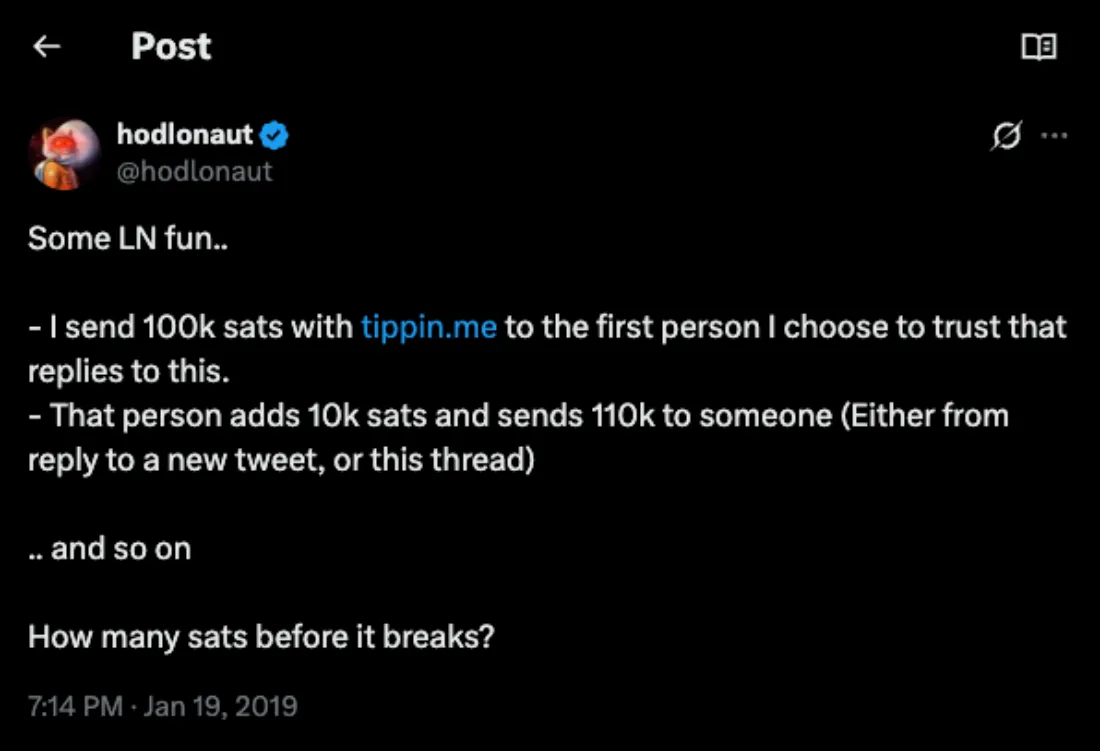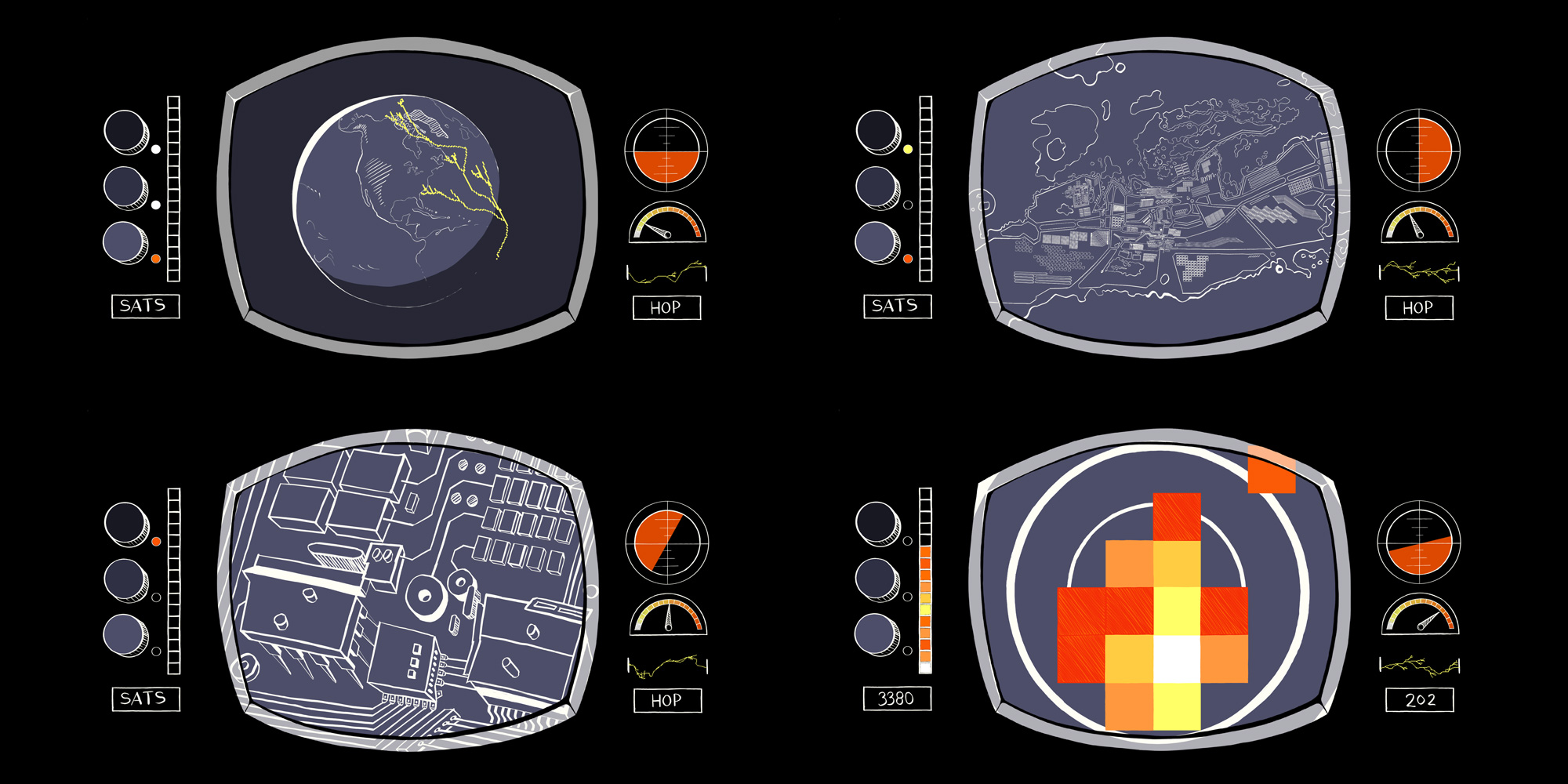A SPARK OF GENIUS
January 19, 2019
1BTC:$3708.963300
- Artist
- Fact Date
- Fact #
- undefined
- Printing Specifications
- Paper / Stock
- Page Size
Bitcoin scaling solution Lightning Network was rolled out in 2019, marked by a “relay” in which hundreds of people passed on a BTC microtransaction. Capable of processing one million transactions per second, Lightning Network promised to transform Bitcoin into a thriving payment network. That promise has yet to manifest – but at least the launch surpassed all expectations.
Has any piece of technology been more hated before it was even released? Lightning Network (LN) came to form a lightning rod for splitting opinions on whether Bitcoin should scale onchain or off. For those who favoured the latter option, LN was the obvious solution.
The concept of a Layer 2 for handling BTC micropayments can be traced all the way back to Satoshi, who in January 2009 ventured: “I would be surprised if 10 years from now we're not using electronic currency in some way…It could get started in a narrow niche like reward points, donation tokens, currency for a game or micropayments for adult sites.”
It’s one thing to have the vision of course – it’s quite another to build it. And Lightning Network proved to be more complex than even its highly accomplished developers would have conceded before starting out. That start began in 2016 when Joseph Poon and Thaddeus Dryja published The Bitcoin Lightning Network whitepaper.
The paper outlined a Layer-2 system of payment channels that could conduct off-chain transactions and settle to the Bitcoin blockchain later, promising near-instant, low-fee payments while retaining Bitcoin’s security. The idea resonated with a handful of early Bitcoin development teams, some of whom decided to take on the task, chief among them Lightning Labs and Blockstream.
A Slow Burner Catches Light
Long before it launched, Lightning Network was to prove a bone of contention within the Bitcoin community. That’s because its developers were all in the #TeamUASF camp, and had supported SegWit, which meant keeping Bitcoin blocks small in the assumption that LN would soon be available to handle payments. For Big Blockers, who insisted on keeping everything on the Bitcoin main chain, LN was verboten from the get-go.
By 2018, however, when Lightning Network finally launched its mainnet beta, the acrimony of the previous year’s Block Wars had faded. The schism had not been entirely forgotten, however, and the Bitcoin community was still divided into Big Blocker (Bitcoin Cash) and Small Blocker (Bitcoin) camps, albeit with the latter attracting the vast majority of user support. Nevertheless, for a subset of Bitcoin users, LN was tainted goods.
Regardless, by early 2019, LN had accrued a few thousand nodes and around 600 BTC capacity, its TVL having grown gently on account of an ultra-soft launch. It might have been Layer-2, but this was Bitcoin after all, and it was critical that nothing broke. Otherwise, all of the trust and years of toil invested in Lightning Network risked evaporating overnight.
With LN running stable in early 2019, the stage was set for a global experiment: the Lightning Torch to showcase the network’s ability to move fractions of BTC between users at negligible cost. The idea had been conceived on January 19th by pseudonymous Twitter user “Hodlonaut.”

Hodlonaut professes to have been inspired by the Lightning Network, recalling: “I had built my own node in autumn 2018 that I tinkered with, and it gave me the same awe-inspiring feeling as making my first onchain bitcoin transactions. I was trying to find excuses to interact with other Lightning users over LN, and had done stuff like giving out sats to the best taco painting on LN-powered game Satoshi’s Place.”
“I had many friends in Bitcoin and was intrigued by the seeming paradox of finding trustworthy people around a protocol that doesn't require trust and promotes verifying yourself. So one day I randomly came up with the idea that I would send some sats to someone I chose to trust and invite them to pass it on to someone they decide to trust, while adding some sats to the amount... Well, it turned out that the idea went viral.”
I think it resonated because it really highlighted Bitcoin's super power,” adds influencer and torch bearer Vijay Boyapati. “I like to say that Bitcoin is like gold with teleportation built in, and the Lightning Network lets you teleport BTC at very low cost.”
Hodlonaut would send 100,000 satoshis (0.001 BTC, about $3.40) via Lightning Network to someone he trusted on Twitter. That person, upon receiving the payment, was to add an additional 10,000 sats (about 35 cents) and then forward the amount to another person they trust and so on. Each hop would increment the “torch” by 10k sats, making the payment snowball. The rules were informal: choose someone you trust to not steal the funds, send them the LN payment, and encourage them to repeat the process.
“How many sats before it breaks?” Hodlonaut pondered. He wouldn’t have to wait long to find out. Bitcoin Twitter enthusiastically embraced the #LNTrustChain, and within hours of his initial tweet, replies poured in from people volunteering to carry the torch. Hodlonaut selected a recipient, passed on the 100k sats, and the chain officially began.
That recipient was Twitter user Fart Face 2000, who spontaneously replied to Hodlonaut’s tweet, duly took receipt of it, and then passed it on, recollecting: “The next morning when I woke up it had doubled or tripled in size because it had been zapped all over the world.”
A website, TakeTheTorch.online, was set up to track its progress, including a world map of torch hops and a list of all participants. What started as a viral experiment quickly turned into a global movement as the Lightning Torch wound its way through dozens of countries, demonstrating Bitcoin’s borderless nature in the process. In its first two weeks alone, the torch was carried by over 100 people across 37 countries. Eventually it would touch every inhabited continent.
In one dramatic episode, a group of Bitcoin users in Venezuela received the Lightning Torch amid a nationwide power blackout. With the electricity out, they improvised by powering their Lightning node using a motorcycle battery to keep the torch moving. This resourcefulness not only kept the experiment alive, but highlighted the real-world enthusiasm for Lightning in communities facing infrastructure challenges.
“The Torch resonated,” reflects journalist Laura Shin, “because we live in a global world and as our world has gone more digital, our online communities have become global. Many of us participate in communities of people around the globe, but our money is not global. The Torch showed a glimpse of the future.”
One of the most high-profile participants in the Lightning Torch experiment was LinkedIn co-founder Reid Hoffman. His motivation for participating was simple: “When new technologies emerge, they rarely begin in boardrooms or massive institutions,” he says. “They start at the grassroots level. That’s the story of the internet itself: from small, distributed communities to something that transformed society. The Lightning Torch was a perfect example of that same spirit.”
He adds: “The duty of technologists, no matter where they are in their careers, is to support grassroots experiments and those pushing past the edges of what we deem possible. By passing the torch publicly, I hoped to underscore that these bottom-up innovations matter; they matter as steps forward in tech, but also as signals of how society might organize itself for the better in the future. Bitcoin is proof that people across the globe can connect, trust the shared framework, and build together. The torch was just a small way to showcase that story.”
The Lightning Torch procession was not without incident, it should be noted. The very premise of the game required trust, which Hodlonaut readily acknowledged. At any point, the parade could grind to a halt should a recipient elect to pocket the change – as several unscrupulous individuals did. But on each occasion, the Bitcoin community dug in and relit the torch, allowing the game to continue.
Recalling his favorite memories from the Lightning Torch event, Hodlonaut cites Jack Dorsey taking the torch and starting following him on Twitter; the early theft of funds “which at first seemed to mark the end, but then the last sender decided to send again to a new person out of his own pocket”; the grandmother in her 80s who held the torch; the torch going to both Israel and Iran within a few days; Jack Mallers sending the torch on from an airplane over the Atlantic; and the overall feeling of positivity in the Bitcoin community.
“One thing I appreciated about the Lightning Torch is how it highlighted Bitcoin's permissionlessness,” reflects Vijay Boyapati. “It was sent to someone in Iran, a country which had sanctions on it, and it showed that peaceful people could still trade with each other voluntarily even if their governments tried to prevent it.”
“It resonated strongly because it was a fun way to test a new technology in a social way,” adds fellow torch bearer Alexander Leishman. “People were still wrapping their heads around Lightning at the time and it felt like the first time we could all play with it interactively.”
The Lightning Torch quickly transcended a mere game and took on rich symbolism for the Bitcoin community, to whom it represented global unity and optimism during a bear market when sentiment was low. This was about more than an onchain game of Chinese Whispers: it was about demonstrating Layer-2 Bitcoin’s ability to function with no banks or borders.
The Torch could only be passed so many times, however, before reaching a built-in Lightning Network payment size cap of around 4.29 million satoshis. After roughly 282 hops, the torch hit this technical limit and had to stop. The final torch bearer, developer Torkel Rogstad, then donated the accumulated 0.0429 BTC – then worth around $170 – to the Bitcoin Venezuela charity.
It was a fitting end to a fine experiment.
- Artist
- XXXXX
- BTC On this day
- January 19, 2019
- Market Cap
- $64,869,768,117
- Block Number
- 559,199
- Hash Rate
- 39,609,871.93 TH/s
- Price Change (1M)
9%
- Price Change (3M)
42%
- Price Change (1Y)
67%
